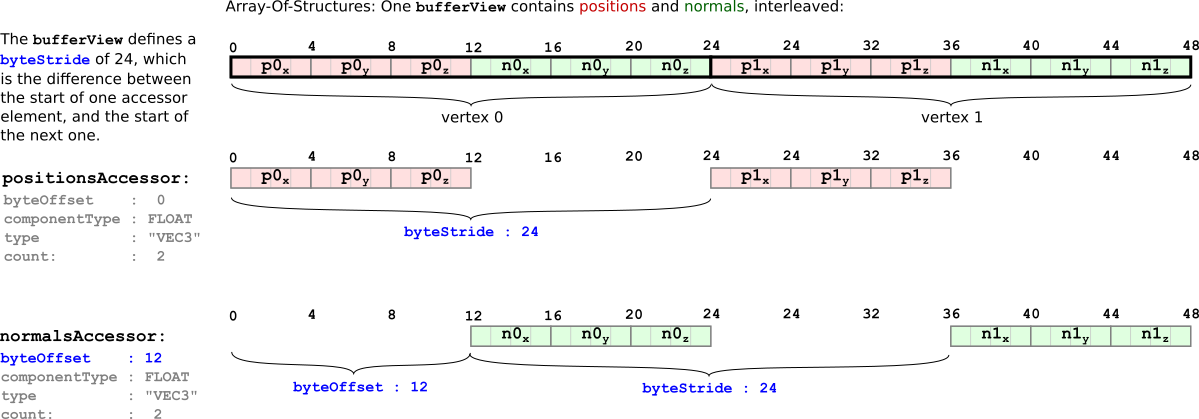Properties of the stride in a glTF file?
The Khronos docs define the stride as:
When a buffer view is used for vertex attribute data, it may have a byteStride property. This property defines the stride in bytes between each vertex.
I am somewhat confused as, many of the examples I have tried already (3 of them) had a stride of 0 so I merely ignored the attribute until now. Those examples render just fine.
I was inferring the "stride" from the type. e.g. if the type was a vec3 and the component type was float, I loaded every 12 bytes as one element. Some things that I am not entirely sure about reading the spec are,
When stride is non 0, does this mean the data could be interleaved?
When the stride is non 0, can the data be non continuous (e.g. padding bytes)?
In other words, can you run into situations where the buffer is not interleaved but the total size of sizeof(type_component) * element_count is not a divisor of the total subsection of memory to be read?
Yes, accessors (in glTF) are like vertex attributes in OpenGL/WebGL, and are allowed to interleave. The stride is on the bufferView, to force accessors that share that bufferView to all have the same stride. A value of zero means "tightly packed".
Note that you may interleave components of different sizes, such as vec3 (POSITION) with vec2 (TEXCOORD_0), so a stride might be the sum of different sizes.
Here's a diagram from the Data Interleaving section of the glTF tutorial. It's a little small here but you can click for a larger view. In this example, there are two accessors, one for POSITION and one for NORMAL, sharing a single BufferView.
- My C code works fine but crashes right before the end (0xC0000374)
- A good way to pass several arguments into one void pointer argument? (C)
- How to force linkage to older libc `fcntl` instead of `fcntl64`?
- Is there a way to get the OpenSSL X509 certificate name that im sending to peer in C++?
- how to pass parameter as a pointer to an array in c
- TCP Socket - printing all chars of a string that are not \n in C not working
- GTK3 Set GtkButton size
- How to compile my own glibc C standard library from source and use it?
- Ninja Build System + gcc/clang doesn't output diagnostic colors
- C pointers understanding
- Strict aliasing violation in C
- Parser in C doesn't store values in a array
- What is the order of evaluation of printf(..) parameters?
- Compare floating point numbers as integers
- Trap representation
- Difference between sqrt(x) and pow(x,0.5)
- Is it possible to have a 32-bit pointer on x86-64 without undefined behavior?
- Can you explain this 'Hello world' program?
- how can i check file write permissions in C++ code?
- Why does my C program give an error when looping through an array?
- Printing char array with null character in the middle in C
- How do I read the source code for a C library in CLion
- pthread nice value setting for default scheduler in C
- Use a 3d array on a function (array that contains arrays that contain strings)
- frida-server being targeted by port scan?
- Are compound literals always lvalue?
- Why is the beginning of a C file stream called `SEEK_SET`?
- How to Take whitespace in Input in C
- "undefined reference to" errors when linking static C library with C++ code
- Audio timescale-pitch modification - Open source examples?
